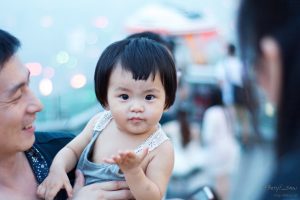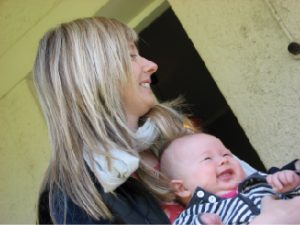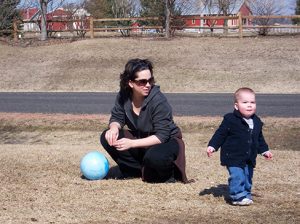1950s: Harlow, Bowlby, and Ainsworth
Lumen Learning and Diana Lang
Harlow and Bowlby: Attachment

Psychosocial development occurs as children form relationships, interact with others, and understand and manage their feelings. In social and emotional development, forming healthy attachments is very important and is the major social milestone of infancy.[1] Attachment is a long-standing connection or bond with others. Developmental psychologists are interested in how infants reach this milestone. They ask questions such questions as: How do parent and infant attachment bonds form? How does neglect affect these bonds? What accounts for children’s attachment differences?
Researchers Harry Harlow, John Bowlby, and Mary Ainsworth conducted studies designed to answer these questions. In the 1950s, Harlow conducted a series of experiments on monkeys. He separated newborn monkeys from their mothers. Each monkey was presented with two surrogate mothers. One surrogate monkey was made out of wire mesh, and she could dispense milk. The other monkey was softer and made from cloth, but did not dispense milk. The findings showed that the monkeys preferred the soft, cuddly cloth monkey, even though she did not provide any nourishment. The baby monkeys spent their time clinging to the cloth monkey and only went to the wire monkey when they needed to be fed. Prior to this study, the medical and scientific communities generally thought that babies become attached to the people who provide their nourishment. However, Harlow concluded that there was more to the mother-child bond than nourishment.[2] Feelings of comfort and security are the critical components of maternal-infant bonding, which leads to healthy psychosocial development.
Video Example
Harlow’s studies of monkeys were performed before modern ethics guidelines were in place, and today his experiments are widely considered to be unethical and even cruel. Watch this video to see footage of Harlow’s monkey studies.
Building on the work of Harlow and others, John Bowlby developed the concept of attachment theory. He defined attachment as the affectional bond or tie that infants form with their mother.[3] An infant must form this bond with a primary caregiver in order to have normal social and emotional development. In addition, Bowlby proposed that this attachment bond is very powerful and continues throughout life. He used the concept of a secure base to define a healthy attachment between parent and child.[4] A secure base is a parental presence that gives the child a sense of safety as he explores his surroundings. Bowlby said that two things are needed for a healthy attachment: the caregiver must be responsive to the child’s physical, social, and emotional needs, and the caregiver and child must engage in mutually enjoyable interactions (See Figure 1.).[5]
Mary Ainsworth

While Bowlby believed that attachment was an all-or-nothing process, Mary Ainsworth’s research showed otherwise.[6] Mary identified the existence of what she calls “attachment behaviors,” which are examples of behaviors demonstrated by insecure children in hopes of establishing or re-establishing an attachment to a presently absent caregiver. ‘Since this behavior occurs uniformly in children, it is a compelling argument for the existence of “innate” or instinctual behaviors in human beings’.[7]
Ainsworth wanted to know if children differ in the ways they bond, and if so, why. To find the answers to these questions, she used the Strange Situation procedure to study attachment between mothers and their infants in 1970. In the Strange Situation, the mother (or primary caregiver) and the infant (age 12-18 months) are placed in a room together. There are toys in the room, and the caregiver and child spend some time alone in the room. After the child has had time to explore one’s surroundings, a stranger enters the room. The primary caregiver then leaves the baby with the stranger. After a few minutes, the caregiver returns to comfort the child.

Based on how the infants/toddlers responded to the separation and reunion, Ainsworth identified three types of parent-child attachments: secure, avoidant, and resistant.[8] A fourth style, known as disorganized attachment, was later described.[9] The most common type of attachment—also considered the healthiest—is called secure attachment (See Figure 2.). In this type of attachment, the toddler prefers their parent over a stranger. The attachment figure is used by the child as a secure base to explore their environment and is sought out in times of stress. Securely attached children were distressed when their caregivers left the room in the Strange Situation experiment, but when their caregivers returned, the securely attached children were happy to see them. Securely attached children have caregivers who are sensitive and responsive to their needs.
With avoidant attachment (sometimes called insecure or anxious-avoidant), the child is unresponsive to the parent, does not use the parent as a secure base, and does not care if the parent leaves. The toddler reacts to the parent the same way she reacts to a stranger. When the parent does return, the child is slow to show a positive reaction. Ainsworth theorized that these children were most likely to have a caregiver who was insensitive and inattentive to their needs.[10]
In cases of resistant attachment (also called ambivalent or anxious-ambivalent/resistant), children tend to show clingy behavior, but then reject the attachment figure’s attempts to interact with them.[11] These children do not explore the toys in the room, as they are too fearful. During separation in the Strange Situation, they became extremely disturbed and angry with the parent. When the parent returns, the children are upset and difficult to comfort. Resistant attachment is the result of the caregivers’ inconsistent level of response to their child.
Finally, children with disorganized attachment behave oddly in the Strange Situation. They freeze, run around the room in an erratic manner, or try to run away when the caregiver returns.[12] This type of attachment is seen most often in children who have been abused. Research has shown that abuse disrupts a child’s ability to regulate their emotions.
Video Example
Watch this video to view a clip of the Strange Situation. Try to identify which type of attachment baby Lisa exhibits.
While Ainsworth’s research has found support in subsequent studies, it has also met criticism. Some researchers have pointed out that a child’s temperament may have a strong influence on attachment, and others have noted that attachment varies from culture to culture, a factor not accounted for in Ainsworth’s research.[13] [14] [15]
Key Takeaways
- Harlow: Contact comfort research concerning wire and cloth monkeys.
- Bowlby: Human attachment theory derived from Harlow’s research.
- Attachment: The connection formed between two individuals over time.
- Secure base: A primary caregiver a child views as “home base” who provides the child with security to actively explore one’s environment.
- Ainsworth: Strange Situation research which led to identifying types of attachment: secure, avoidant, disorganized, and resistant attachment.
- This chapter is an adaptation of Childhood by Lumen Learning, used under a CC BY 4.0 license. ↵
- Harlow, H. F. (1958). The nature of love. American Psychologist, 13(1), 673-685. ↵
- Bowlby, J. (1969). Attachment and loss, vol. 1: Attachment. Basic Books. ↵
- Bowlby, J. (1988). A secure base: Parent-child attachment and healthy human development. Basic Books. ↵
- Bowlby, J. (1969). Attachment and loss, vol. 1: Attachment. Basic Books. ↵
- Ainsworth, M. D. S., & Bell, S. M. (1970). Attachment, exploration, and separation: Illustrated by the behavior of one-year-olds in a strange situation. Child Development,41(1), 49-67. ↵
- Psychologist World. (2019). Attachment theory. https://www.psychologistworld.com/developmental/attachment-theory ↵
- Ainsworth, M. D. S., & Bell, S. M. (1970). Attachment, exploration, and separation: Illustrated by the behavior of one-year-olds in a strange situation. Child Development, 41(1), 49-67. ↵
- Main, M., & Solomon, J. (1990). Procedures for identifying infants as disorganized/disoriented during the Ainsworth Strange Situation. In M. T. Greenberg, D. Cicchetti, & E. M. Cummings (Eds.), Attachment in the preschool years: Theory, research, and intervention (pp. 121-160). University of Chicago Press. ↵
- Ainsworth, M. D. S., Blehar, M. C., Waters, E., & Wall, S. (1978). Patterns of attachment: A psychological study of the Strange Situation. Erlbaum. ↵
- Ainsworth, M. D. S., & Bell, S. M. (1970). Attachment, exploration, and separation: Illustrated by the behavior of one-year-olds in a strange situation. Child Development, 41(1), 49-67. ↵
- Main, M., & Solomon, J. (1990). Procedures for identifying infants as disorganized/disoriented during the Ainsworth Strange Situation. In M. T. Greenberg, D. Cicchetti, & E. M. Cummings (Eds.), Attachment in the preschool years: Theory, research, and intervention (pp. 121-160). University of Chicago Press. ↵
- Gervai, J. (2009). Environmental and genetic influences on early attachment. Child and Adolescent Psychiatry and Mental Health, 3(1), 25. https://doi.org/10.1186/1753-2000-3-25 ↵
- Harris, J. R. (2009). Attachment theory underestimates the child. Behavioral and Brain Sciences, 32(1), 30. https://doi.org/10.1017/S0140525X09000119 ↵
- Van Ijzendoorn, M. H., & Sagi-Schwartz, A. (2008). Cross-cultural patterns of attachment: Universal and contextual dimensions. In J. Cassidy & P. R. Shaver (Eds.), Handbook of attachment: Theory, research and clinical applications (pp. 880–905). Guilford Press. ↵
An emotional, long-standing connection or bond with others.
A parental or primary caregiver presence that gives infants/toddlers a sense of safety as they explore their surroundings.
An attachment style characterized by a child using a parent or primary caregiver as a secure base from which to explore.
Characterized by an unresponsive child who treats the parent as a stranger.
An attachment style characterized by the child’s tendency to show clingy behavior and rejection of the parent when the parent and child are interacting.
An attachment style characterized by the child’s ambivalent behavior when faced with the parent; a type of attachment seen most often with children who have been abused.

